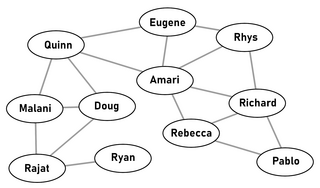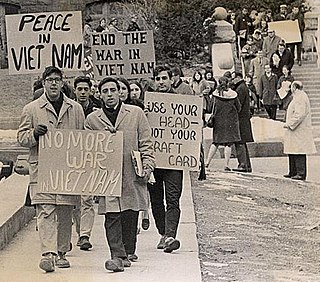
In sociology, socialization is the process of internalizing the norms and ideologies of society. Socialization encompasses both learning and teaching and is thus "the means by which social and cultural continuity are attained".

Social norms are shared standards of acceptable behavior by groups. Social norms can both be informal understandings that govern the behavior of members of a society, as well as be codified into rules and laws. Social normative influences or social norms, are deemed to be powerful drivers of human behavioural changes and well organized and incorporated by major theories which explain human behaviour. Institutions are composed of multiple norms. Norms are shared social beliefs about behavior; thus, they are distinct from "ideas", "attitudes", and "values", which can be held privately, and which do not necessarily concern behavior. Norms are contingent on context, social group, and historical circumstances.
Group dynamics is a system of behaviors and psychological processes occurring within a social group, or between social groups. The study of group dynamics can be useful in understanding decision-making behaviour, tracking the spread of diseases in society, creating effective therapy techniques, and following the emergence and popularity of new ideas and technologies. These applications of the field are studied in psychology, sociology, anthropology, political science, epidemiology, education, social work, leadership studies, business and managerial studies, as well as communication studies.

Military recruit training, commonly known as basic training or boot camp, refers to the initial instruction of new military personnel. It is a physically and psychologically intensive process, which resocializes its subjects for the unique demands of military employment.

In the social sciences, a social group is defined as two or more people who interact with one another, share similar characteristics, and collectively have a sense of unity. Regardless, social groups come in a myriad of sizes and varieties. For example, a society can be viewed as a large social group. The system of behaviors and psychological processes occurring within a social group or between social groups is known as group dynamics.

Youth culture refers to the societal norms of children, adolescents, and young adults. Specifically, it comprises the processes and symbolic systems that are shared by the youth and are distinct from those of adults in the community.
Acculturation is a process of social, psychological, and cultural change that stems from the balancing of two cultures while adapting to the prevailing culture of the society. Acculturation is a process in which an individual adopts, acquires and adjusts to a new cultural environment as a result of being placed into a new culture, or when another culture is brought to someone. Individuals of a differing culture try to incorporate themselves into the new more prevalent culture by participating in aspects of the more prevalent culture, such as their traditions, but still hold onto their original cultural values and traditions. The effects of acculturation can be seen at multiple levels in both the devotee of the prevailing culture and those who are assimilating into the culture.

An institution is a humanly devised structure of rules and norms that shape and constrain social behavior. All definitions of institutions generally entail that there is a level of persistence and continuity. Laws, rules, social conventions and norms are all examples of institutions. Institutions vary in their level of formality and informality.
Role theory is a concept in sociology and in social psychology that considers most of everyday activity to be the acting-out of socially defined categories. Each role is a set of rights, duties, expectations, norms, and behaviors that a person has to face and fulfill. The model is based on the observation that people behave in a predictable way, and that an individual's behavior is context specific, based on social position and other factors. Research conducted on role theory mainly centers around the concepts of consensus, role conflict, role taking, and conformity. The theatre is a metaphor often used to describe role theory.

Military education and training is a process which intends to establish and improve the capabilities of military personnel in their respective roles. Military training may be voluntary or compulsory duty. It begins with recruit training, proceeds to education and training specific to military roles, and sometimes includes additional training during a military career. Directing staff are the military personnel who comprise the instructional staff at a military training institution.
In social justice theory, internalized oppression is a recognized understanding in which an oppressed group accepts the methods and incorporates the oppressive message of the oppressing group against their own best interest. Rosenwasser (2002) defines it as believing, adopting, accepting, and incorporating the negative beliefs provided by the oppressor as the truth.

Sociology of terrorism is a field of sociology that seeks to understand terrorism as a social phenomenon. The field defines terrorism, studies why it occurs and evaluates its impacts on society. The sociology of terrorism draws from the fields of political science, history, economics and psychology. The sociology of terrorism differs from critical terrorism studies, emphasizing the social conditions that enable terrorism. It also studies how individuals as well as states respond to such events.
Social conditioning is the sociological process of training individuals in a society to respond in a manner generally approved by the society in general and peer groups within society. The concept is stronger than that of socialization, which is the process of inheriting norms, customs and ideologies. Manifestations of social conditioning are vast, but they are generally categorized as social patterns and social structures including nationalism, education, employment, entertainment, popular culture, religion, spirituality and family life. The social structure in which an individual finds him or herself influences and can determine their social actions and responses.

Onboarding or organizational socialization is the American term for the mechanism through which new employees acquire the necessary knowledge, skills, and behaviors to become effective organizational members and insiders. In standard English, this is referred to as "induction". In the United States, up to 25% of workers are organizational newcomers engaged in onboarding process.

Situational sexual behavior is a type of sexual behavior which differs from that which the person normally exhibits, due to a social environment that in some way permits, encourages, or compels the behavior in question. This can include situations where a person's preferred sexual behavior may not be possible, so rather than refraining from sexual activity completely, they may engage in substitute sexual behaviors.

Deviance or the sociology of deviance explores the actions and/or behaviors that violate social norms across formally enacted rules as well as informal violations of social norms. Although deviance may have a negative connotation, the violation of social norms is not always a negative action; positive deviation exists in some situations. Although a norm is violated, a behavior can still be classified as positive or acceptable.
Anticipatory socialization is the process, facilitated by social interactions, in which non-group members learn to take on the values and standards of groups that they aspire to join, so as to ease their entry into the group and help them interact competently once they have been accepted by it. It involves changing one's attitudes and behaviours in preparation for a shift in one's role. Words commonly associated with anticipatory socialization include grooming, play-acting, training, and rehearsing. Examples of anticipatory socialization include law school students learning how to behave like lawyers, older people preparing for retirement, and Mormon boys getting ready to become missionaries.
In sociology and other social sciences, internalization means an individual's acceptance of a set of norms and values through socialisation.
Primary socialization in sociology is the period early in a person's life during which they initially learn and develop themselves through experiences and interactions. This process starts at home through the family, in which one learns what is or is not accepted in society, social norms, and cultural practices that eventually one is likely to take up. Primary socialization through the family teaches children how to bond, create relationships, and understand important concepts including love, trust, and togetherness. Agents of primary socialization include institutions such as the family, childhood friends, the educational system, and social media. All these agents influence the socialization process of a child that they build on for the rest their life. These agents are limited to people who immediately surround a person such as friends and family—but other agents, such as social media and the educational system have a big influence on people as well. The media is an influential agent of socialization because it can provide vast amounts of knowledge about different cultures and society. It is through these processes that children learn how to behave in public versus at home, and eventually learn how they should behave as people under different circumstances; this is known as secondary socialization. A vast variety of people have contributed to the theory of primary socialization, of those include Sigmund Freud, George Herbert Mead, Charles Cooley, Jean Piaget and Talcott Parsons. However, Parsons' theories are the earliest and most significant contributions to socialization and cognitive development.

Legal socialization is the process through which, individuals acquire attitudes and beliefs about the law, legal authorities, and legal institutions. This occurs through individuals' interactions, both personal and vicarious, with police, courts, and other legal actors. To date, most of what is known about legal socialization comes from studies of individual differences among adults in their perceived legitimacy of law and legal institutions, and in their cynicism about the law and its underlying norms. Adults' attitudes about the legitimacy of law are directly tied to individuals' compliance with the law and cooperation with legal authorities.










